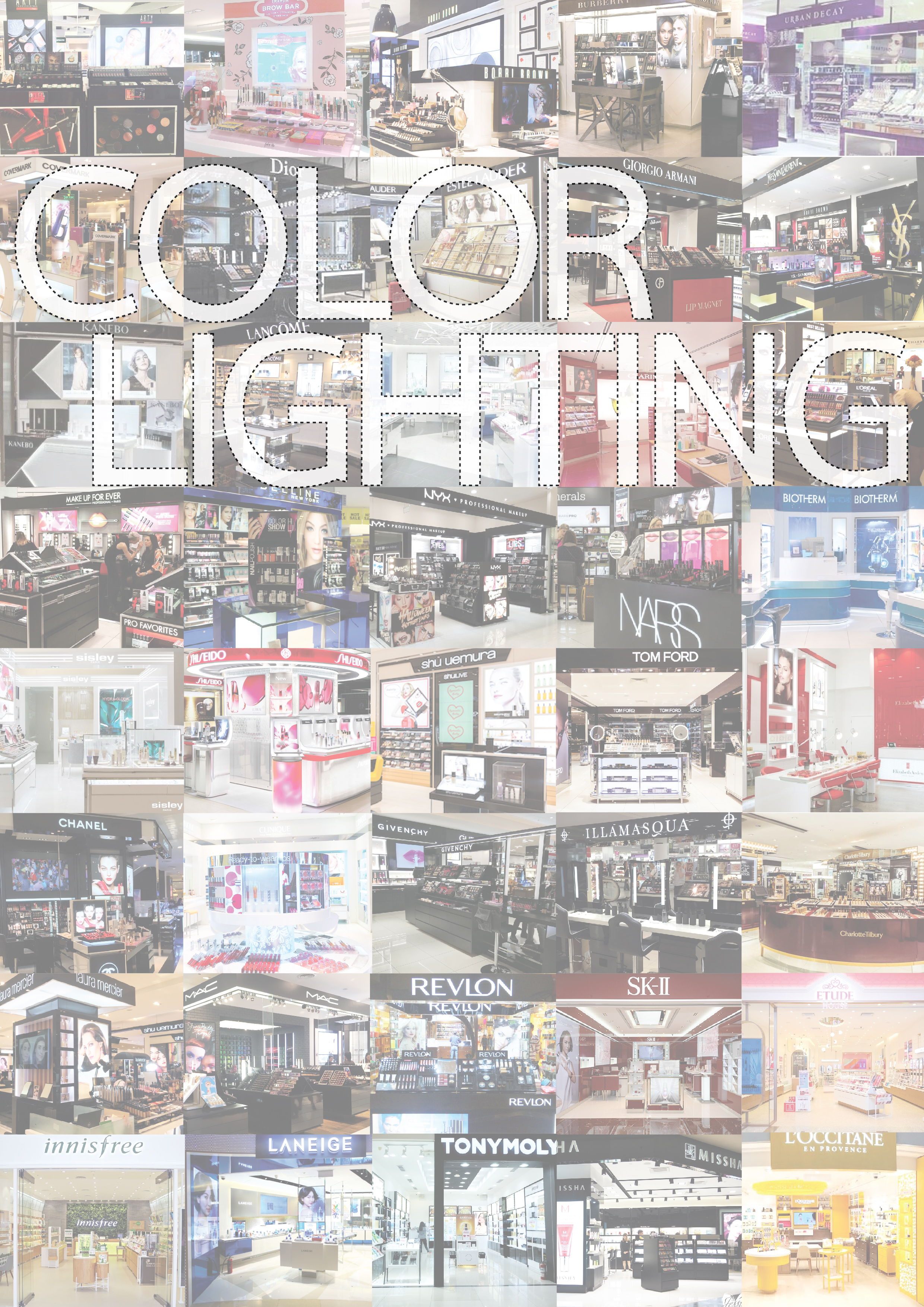คุณลักษณะของสีและแสงต่อความพึงพอใจของผู้หญิง: กรณีศึกษา เคาน์เตอร์เครื่องสำอาง
Main Article Content
บทคัดย่อ
ธุรกิจความงามมีอัตราการเจริญเติบโตอย่างต่อเนื่องและมีการแข่งขันสูง ส่งผลให้บริษัทเครื่องสำอางต่างพัฒนาเคาน์เตอร์เครื่องสำอางเพื่อดึงดูดผู้บริโภค การออกแบบแสงเป็นเทคนิคหนึ่งที่สามารถสร้างบรรยากาศที่ดีรวมไปถึงการออกแบบแสงกับกระจกให้ลูกค้าได้ลองใช้สินค้าร่วมกับการประเมินรูปลักษณ์ตนเองเพื่อพิจารณาการซื้อเครื่องสำอาง การวิจัยนี้มุ่งเน้นศึกษาคุณลักษณะของสีและแสงต่อความพึงพอใจของผู้หญิงในเคาน์เตอร์เครื่องสำอาง จากผู้เข้าร่วม 60 คน เข้าทดสอบแบบจำลองเคาน์เตอร์เครื่องสำอางจุดแต่งหน้าที่จัดแสงด้วยลักษณะอุณหภูมิสีของแสง 2700 K และ 6500 K โดยใช้สีผนังที่แตกต่างกัน ได้แก่ สีแดง สีน้ำเงิน สีขาว และสีดำ เพื่อศึกษาผลต่อความพึงพอใจในสภาพแวดล้อมและการประเมินรูปลักษณ์ตนเองด้วยการให้คะแนนจากคู่คำความหมายตรงข้าม 8 คู่ ศึกษาในกลุ่มประชากรผู้หญิงผิวขาวและผิวแทน พบว่าลักษณะอุณหภูมิสีของแสงและสีของสภาพแวดล้อมมีผลต่อความพึงพอใจของผู้หญิงอย่างมีนัยสำคัญทางสถิติ (p<0.05) โดยเคาน์เตอร์เครื่องสำอางที่ใช้อุณหภูมิสีของแสง 6500 K ส่งผลต่อความพึงพอใจมากที่สุดในผู้หญิงผิวขาวและแทน โดยมีความพึงพอใจในสภาพแวดล้อมผนังสีขาว รองลงมาคือผนังสีแดง งานวิจัยนี้สรุปว่าคุณลักษณะของสีและแสงในสภาพแวดล้อมเป็นปัจจัยสำคัญในการออกแบบที่มีส่วนสร้างอารมณ์ในเชิงบวกต่อการประเมินรูปลักษณ์ตนเองและสภาพแวดล้อมเคาน์เตอร์เครื่องสำอาง
Article Details
เอกสารอ้างอิง
Amornsiriwattanakul, P. (2013). Phonkrathob khong si saengfai tor kwam sonchai tang karn monghen tu cho ran khrueang sam ang. (In Thai) [Impact of colored light on visual interest in window display of cosmetic shop]. (Master’s thesis). Bangkok: King Mongkut’s University of Technology Thonburi.
Baker, J., Levy M., & Grewal, D. (1992). An experimental approach to making retail store environmental decisions. Journal of Retailing, 68 (4), 445-60.
Baumstarck, A. & Park N. (2010). The effects of dressing room lighting on consumers perceptions of self and environment. Journal of Interior Design, 35 (2), 37-49.
Bonnardel, V., et al. (2017). Gender difference in color preference across cultures: an archetypal pattern modulated by a female cultural stereotype. Color Research & Application, 43 (2), 209–223.
Boissard, S., Anovac, P. & Fontoynont, M. (2016). Preferred color rendition of skin under LED sources. LEUKOS The Journal of the Illuminating Engineering Society of North America, 12 (1-2), 79-93.
Donovan & Rossiter. (1982). Store atmosphere: an environmental psychology approach. Journal of Retailing, 58 (1), 34-57.
He, J., et al. (2017). Preference for appearance of Chinese complexion under different lighting. Lighting Research and Technology, 49 (2), 228-242.
Hengevelt, J. (2014). Dressing rooms: love it or leave it. (Master’s thesis). Netherlands: University of Twente.
Hulshof, B. (2013). The influence of colour and scent on people’s mood and cognitive performance meeting rooms. (Master’s thesis). Enschede: University of twente.
Illuminating Engineering Association of Thailand. (2016). Khumue neawtang karn oakbab karn song sawang phainai arkhan. (In Thai). [Guidelines for indoor lighting design]. Bangkok: Author.
International Trade Administration. (2019). Thailand personal care market size. Retrieved September 8, 2019, from https://www.export.gov/article?id=Thailand-personal-care-and-beauty-products.
Ishihara, S. (1972) .The series of plates designed as a test for colour-blindness. Tokyo: Kanerhara shuppan.
Iwai, W., Saito, T. & Yamagushi, S. (2016). Development LED lighting luminaire for realizing preferred appearance of facial skin color by spectrum control. Panasonic Journal, 40 (4), 262-267.
Kwallek, N. & Lewis, C. M. (1990). Effects of environment colour on males and females: red or white or green office. Applied Ergonomics, 21 (4), 275-278.
Lee, W. Y., Gong, S. M. & Leung, C. Y. (2009). Is color preference affected by age difference. International Association of Societies of Design Research, 1837-1846.
Likert, R. (1932). A technique for the measurement of attitudes. New York: Archives of psychology.
Lin, Y. & Yoon, S. (2015). Exploring the effects of lighting on consumer responses in a retail environment using 3D walk-through animation. Archives of Design Research, 28 (2), 5-25.
Mehrabian, A. & Russell, J. A. (1974). An approach to environmental psychology. Cambridge: MIT Press.
Melgosa, M., et al. (2018). Colour differences in Caucasian and Oriental women’s faces illuminated by white light-emitting diode sources. International Journal of Cosmetic Science, 40 (3), 244-255.
Okuda, S., & Okajima, K. (2016). Effects of spectral component of light on appearance of skin of woman’s face with make-up. Journal of Light & Visual Environment, 40, 20-27.
Park, N., & Farr, C. (2007). The effects of lighting on consumers emotions and behavioral intentions in a retail environment: a cross-cultural comparison. Journal of Interior Design, 33 (1), 17-32.
Quellman, E. & Boyce, P. (2002). The light source color preferences of people of different skin tones. Journal of the Illuminating Engineering Society, 31 (1), 109-118.
Rea, M.S. (2000). IESNA Lighting handbook:reference and application. New York: IESNA Publications Department.
Snider, J.G. & Osgood C.E. (1969). Semantic differential scaling. Venice: Aldine Publishing Company.
Summers, T. & Hebert, P. (2001). Shedding some light on store atmospherics: Influence of illumination on consumer behavior. Journal of business Research, 54 (2), 145- 150.
Warakul, T. (2017). Itthiphon khong klum si tor arom lae karn tatsinchai khao ran ahan.
(In Thai) [The influence of color combination on emotion and restaurant entry decision]. (Doctoral dissertation). Bangkok: Chulalongkorn University.
Wiratchakul, W. (2015). Luksana chapho choeng sapektram khong si phio khon Thai. (In Thai) [Spectral characteristics of Thai skin colour] (Master’s thesis). Bangkok: Chulalongkorn University. i
Yano, T. & Hashimoto, K. (2015). Preference index for Japanese complexion under illuminations. Color Research and Application, 41 (2), 143-153.
Yildirim, K., et al. (2012). Effect of wall colour on the perception of hairdressing salons. Journal of the International Colour Association, 7, 51-63.
Yu, H., & Akita, T. (2019). The effect of illuminance and correlated colour temperature on perceived comfort according to reading behavior in a capsule hotel. Building and Environment, 148, 384-393.


